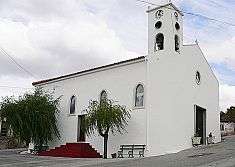Alvega
| Alvega | |||
| Former Civil Parish | |||
|
|||
| Official name: Freguesia de Alvega | |||
| Country | |||
|---|---|---|---|
| Region | Centro | ||
| Subregion | Médio Tejo | ||
| District | Santarém | ||
| Municipality | Abrantes | ||
| Area | 55.33 km2 (21 sq mi) | ||
| Population | 1,499 (2011) | ||
| Timezone | WET (UTC0) | ||
| - summer (DST) | WEST (UTC0) | ||
| Area Code & Prefix | (+351) 241 XX XX XX | ||
| Wikimedia Commons: Alvega | |||
| Website: http://www.alvega.info | |||
Alvega is a former civil parish, located in the municipality of Abrantes, in Santarém District, Portugal. In 2013, the parish merged into the new parish Alvega e Concavada.[1] The population in 2011 was 1,499,[2] in an area of 55.33 km².[3]
History

On top of a hilltop encountered 300 metres (980 ft) to the southwest of the confluence of the Tagus River with the Lampreia River, in the area of Barca de Bandos, are the ruins of a fortress. The vestiges of the surface area indicate the presence of the Phoenicians and Greeks.
By the time the Romans began occupying the Iberian peninsula around 130, the area was already an important community, designated Ayre or Aritium, with river port that provided a military connection between Lisbon and Mérida. The destruction of the Roman fort was attributed to the invasion of Vandals, on their way to Andalusia. Of this Roman civitas there are still some buildings, house foundations and graves, underground galleries, likely the ruins of an aqueduct, military roads, and along the Tagus, there are markers to indicate a Roman bridge.
During the Muslim occupation the city continued to support a populous community. The toponymy, Alvega, came from the Arab name Alrega, with its history extending as far back as the Muslim occupation of Hispania.
Geography
The parish is located in the easternmost tip of the municipality, neighbouring with the municipalities of Mação to the north, with Gaviãoto the east and with Ponte de Sor to the south.
The parish includes the localities of Alvega, Areia de Baixo, Areia de Cima, Casa Branca, Casal Ventoso, Lampreia, Monte Galego, Portelas and Tubaral.
It is situated on the left margin of the Tagus River, 17 kilometres (11 mi) from the municipal seat of Abrantes. It is the centre of the Beira Baixa rail-line, in addition to having two river ports along the Tagus in Alvega and Barca de Bandos.
Economy
Alvega is essentially rural, involved in the cultivation of cereal grains, cork and olive orchards, as well as the raising of goats and sheep. In addition the extration of sand from the river, the fishery, horticulture and fructiculture, among other activities are important parts of the local primary sector economies.
Meanwhile, there are portions of the community involved in traditional tin, carpentry, tailoring and embroidery crafts, as a source of tourist dollars.
References
- ↑ Diário da República. "Law nr. 11-A/2013, pages 552 4" (pdf) (in Portuguese). Retrieved 4 July 2014.
- ↑ Instituto Nacional de Estatística
- ↑ Eurostat Archived September 6, 2014, at the Wayback Machine.

